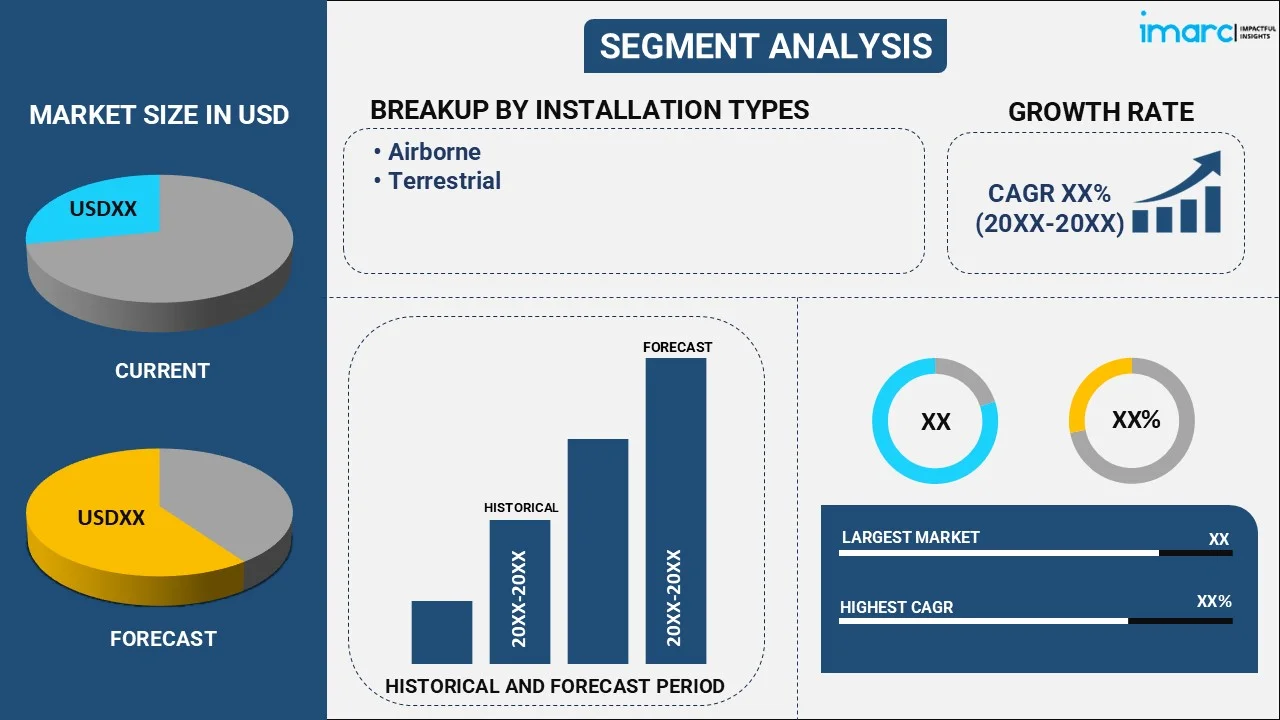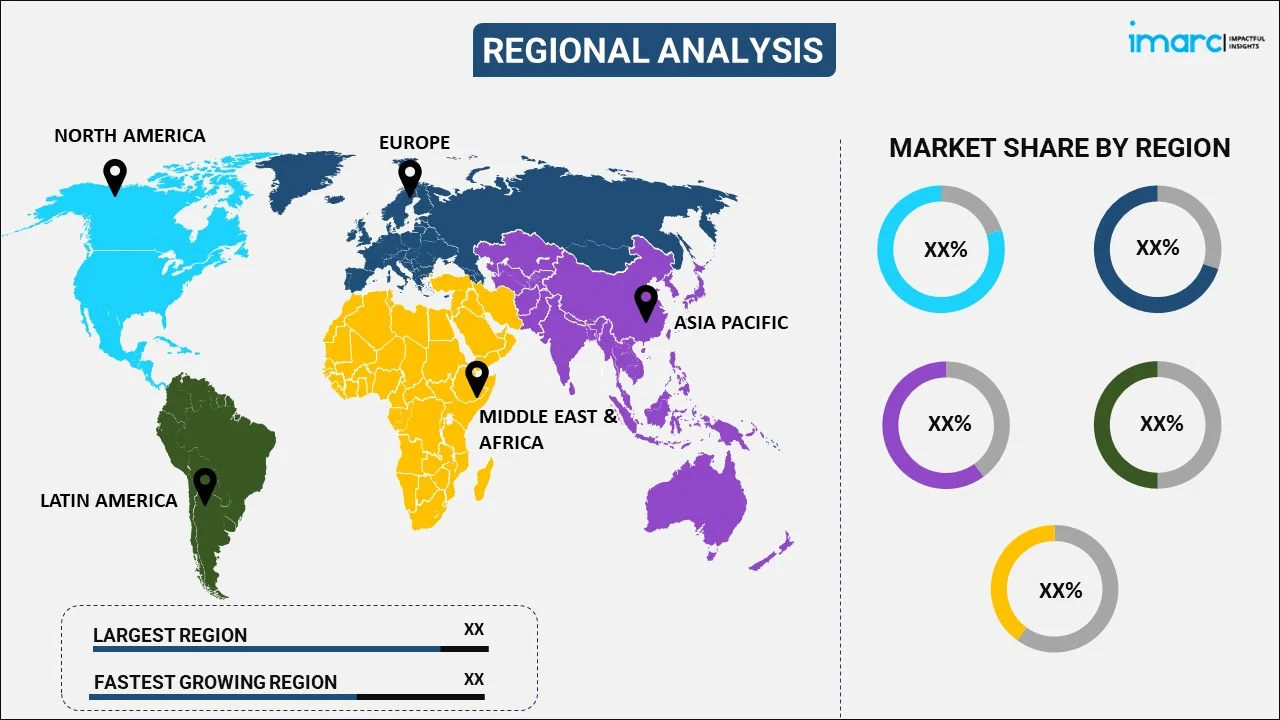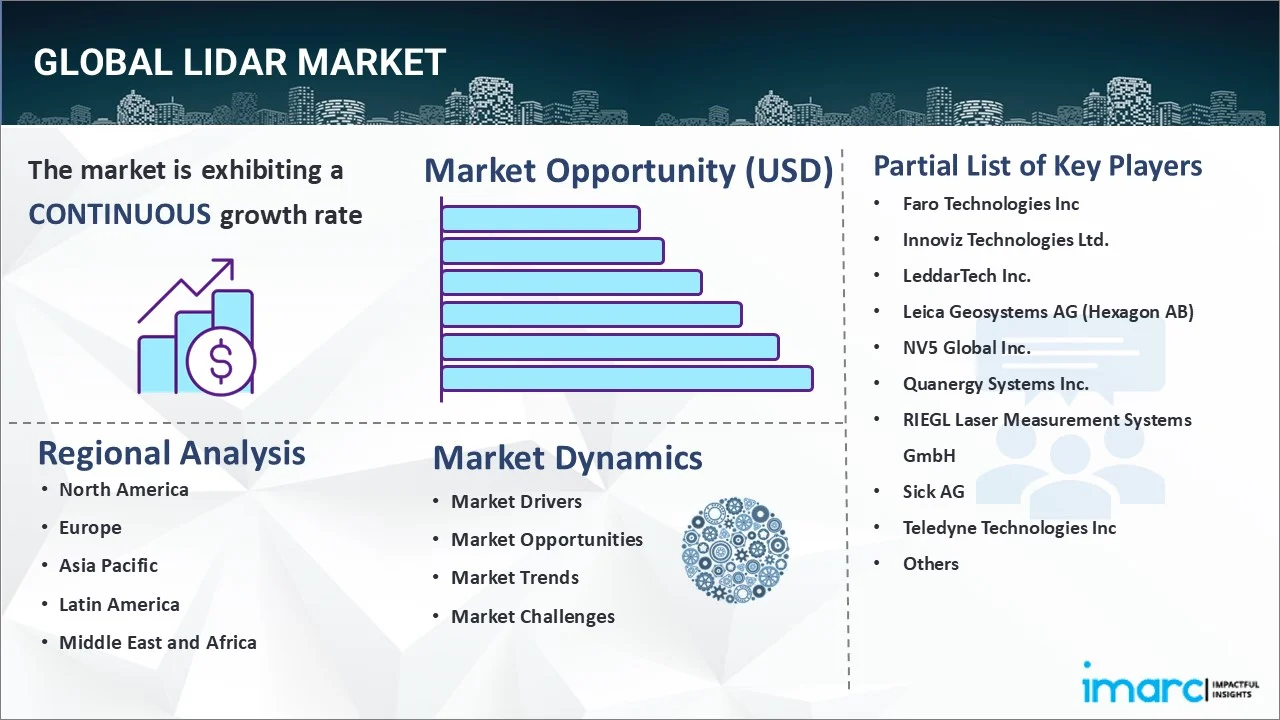
LiDAR Market Report by Installation Type (Airborne, Terrestrial), Component (Laser Scanners, Navigation Systems, Global Positioning Systems, and Others), Application (Corridor Mapping, Engineering, Environment, Exploration, ADAS, and Others), and Region 2025-2033
LiDAR Market Overview:
The global LiDAR market size reached USD 3.1 Billion in 2024. Looking forward, IMARC Group expects the market to reach USD 13.3 Billion by 2033, exhibiting a growth rate (CAGR) of 17.66% during 2025-2033. The demand for autonomous vehicles, rising population in urban areas, and increasing precision agriculture is strengthening the growth of the market.
|
Report Attribute
|
Key Statistics
|
|---|---|
|
Base Year
|
2024
|
|
Forecast Years
|
2025-2033
|
|
Historical Years
|
2019-2024
|
|
Market Size in 2024
|
USD 3.1 Billion |
|
Market Forecast in 2033
|
USD 13.3 Billion |
| Market Growth Rate 2025-2033 | 17.66% |
LiDAR Market Analysis:
- Major Market Drivers: There is a rise in the demand for improved automated processing capability of LiDAR scanners. This, along with the increasing adoption of 3D imagining technology, is driving the market.
- Key Market Trends: The growing applications of LiDAR in numerous industries and adoption of innovative technologies are facilitating the market growth.
- Geographical Trends: North America holds the largest segment because of strong regulatory framework for autonomous vehicles mapping application.
- Competitive Landscape: Some of the major market players in the LiDAR industry include Faro Technologies Inc, Innoviz Technologies Ltd., LeddarTech Inc., Leica Geosystems AG (Hexagon AB), NV5 Global Inc., Quanergy Systems Inc., RIEGL Laser Measurement Systems GmbH, Sick AG, Teledyne Technologies Inc, Trimble Inc., Valeo, Velodyne Lidar Inc., among many others.
- Challenges and Opportunities: While the market faces challenges like a lack of awareness about the LiDAR systems, which impacts the market, it also encounters opportunities in the integration of LiDAR with other technologies like artificial intelligence (AI).
LiDAR Market Trends:
Rising demand for autonomous vehicles (AVs)
The IMARC Group’s report shows that the global autonomous vehicles market reached US$ 81.0 Billion in 2023. AVs use high-tech sensors to identify the conditions of the surroundings and navigate the traffic environment independently. As safety is a top priority in the development of automated vehicles, the need of LiDAR sensor technology, which offer precise and reliable detection, is increasing continuously. Besides the cameras, radar and other sensors, LiDAR is used to create a real-time 360-degree view of the surroundings of AVs. LiDAR sensors provide precise distance measurements, allowing for informed decisions by AVs and safe navigation in all driving conditions like complex urban settings and challenging weather conditions.
Growing population in urban areas
The World Bank’s report claims that around 50% of the population was residing in urban areas in 2023. There is a growing need for the development of efficient transportation systems and traffic management solutions. LiDAR technology is used to gather information on road networks, traffic patterns, and pedestrian flows, which, in turn, helps the transportation planners to optimize traffic signals, design the safer intersections, and plan the public transportation routes more efficiently. Besides this, the increasing urban population is leading to the need for more infrastructure development, such as roads, buildings and utilities. LiDAR technology is the main component of urban planning and development as it provides the 3D mapping and modeling of urban environments. Urban planners utilize LiDAR data to evaluate land use, study the transportation networks and to make the city layout for efficient use of space and resources, thereby contributing to the LiDAR market growth.
Increasing adoption of precision agriculture
The application of LiDAR technology in precision agriculture makes it possible to carry out sustainable farming by reducing the input usage, limiting the environmental impact, and improving the resource efficiency. In line with this, LiDAR technology aids in the precision planting and harvesting by providing the exact measurements of plant spacing, row alignment, and crop maturity. This data enables farmers to modify the planting densities, reduce the crop damage during harvesting, and increase the harvesting efficiency, which, consequently, results in higher yields and lower operational costs. According to the IMARC Group’s report, the global precision agriculture market is expected to reach US$ 20.2 Billion by 2032.
LiDAR Market Segmentation:
IMARC Group provides an analysis of the key trends in each segment of the market, along with LiDAR market forecasts at the global, regional, and country levels for 2025-2033. Our report has categorized the market based on installation type, component, and application.
Breakup by Installation Type:

- Airborne
- Terrestrial
The report has provided a detailed breakup and analysis of the market based on the installation type. This includes airborne and terrestrial.
Airborne LiDAR systems are installed on the aircraft or drones which enable them to shoot a large portion of the terrain in a short time with great precision and efficiency. This ability shows that airborne LiDAR is perfect for tasks, such as topographic mapping, land surveying, urban planning, and forestry management. Besides this, airborne LiDAR is commonly used in the inspection of infrastructure, disaster management, and environmental monitoring, which involve remote or inaccessible areas, where access is not possible.
Terrestrial LiDAR systems are ground-based and usually fitted on tripods or vehicles, as they can record the 3D data of stationary objects or environments with high accuracy. They are used in several applications like topographic mapping, urban planning, infrastructure monitoring, and cultural heritage preservation. In the fields of surveying and mapping, terrestrial LiDAR systems are perfect for capturing detailed terrain and building feature, which helps in creating the accurate digital elevation models (DEMs) and the 3D city models. This, in turn, is catalyzing the LiDAR demand across the globe.
Breakup by Component:
- Laser Scanners
- Navigation Systems
- Global Positioning Systems
- Others
Laser scanners holds the largest share of the industry
A detailed breakup and analysis of the market based on the component have also been provided in the report. This includes laser scanners, navigation systems, global positioning systems, and others. According to the report, laser scanners account for the largest market share.
Laser scanners emit laser beams and measure the time it takes for the light to return after hitting an object, thus creating highly detailed 3D maps of the surrounding environment. In industries, such as automotive, laser scanners are essential components for autonomous vehicles and advanced driver assistance systems (ADAS), providing a crucial data for navigation, obstacle detection, and collision avoidance. Additionally, laser scanners are extensively used in topographic mapping, urban planning, forestry management, and infrastructure inspection.
Breakup by Application:
- Corridor Mapping
- Engineering
- Environment
- Exploration
- ADAS
- Others
Corridor mapping represents the leading market segment
The report has provided a detailed breakup and analysis of the market based on the application. This includes corridor mapping, engineering, environment, exploration, ADAS and others. According to the report, corridor mapping represents the largest segment.
Corridor mapping involves the detailed surveying and mapping of linear features such as roads, highways, railways, pipelines, and power lines. These infrastructure projects require precise and accurate data for design, construction, and maintenance purposes. LiDAR technology offers significant advantages in corridor mapping by providing high-resolution 3D data quickly and efficiently, even in challenging terrains or densely vegetated areas. This data enables engineers, urban planners, and government agencies to assess existing infrastructure conditions, plan new developments, and optimize transportation networks effectively, thereby increasing the LiDAR market revenue.
Breakup by Region:

- North America
- United States
- Canada
- Asia-Pacific
- China
- Japan
- India
- South Korea
- Australia
- Indonesia
- Others
- Europe
- Germany
- France
- United Kingdom
- Italy
- Spain
- Russia
- Others
- Latin America
- Brazil
- Mexico
- Others
- Middle East and Africa
North America leads the market, accounting for the largest LiDAR market share
The report has also provided a comprehensive analysis of all the major regional markets, which include North America (the United States and Canada); Asia Pacific (China, Japan, India, South Korea, Australia, Indonesia, and others); Europe (Germany, France, the United Kingdom, Italy, Spain, Russia, and others); Latin America (Brazil, Mexico, and others); and the Middle East and Africa. According to the report, North America represents the largest regional market for LiDAR.
As per the International Trade Administration, Canada light vehicle market increased 6.6% to 1.64 million units in 2021. The growing sales of light vehicles in the United States are driving the demand of LiDAR primarily due to the increasing integration of LiDAR technology into advanced driver assistance systems (ADAS) and autonomous vehicle (AV) platforms. In addition, North America consists of large number of established LiDAR technology providers and key players, thereby driving innovations and advancements in technology in the industry. Moreover, there is a rise in the demand for LiDAR across multiple industries, such as automotive, aerospace, defense, and agriculture, in the region.
Competitive Landscape:
- The market research report has also provided a comprehensive analysis of the competitive landscape in the market. Detailed profiles of all major LiDAR companies have also been provided. Some of the major market players in the LiDAR industry include Faro Technologies Inc, Innoviz Technologies Ltd., LeddarTech Inc., Leica Geosystems AG (Hexagon AB), NV5 Global Inc., Quanergy Systems Inc., RIEGL Laser Measurement Systems GmbH, Sick AG, Teledyne Technologies Inc, Trimble Inc., Valeo, and Velodyne Lidar Inc.
(Please note that this is only a partial list of the key players, and the complete list is provided in the report.)
- Major players in the LiDAR industry offers innovative technologies to expand and survive in a competitive market environment. Additionally, key players are continuously investing in research and development (R&D) activities to increase their product offering, thereby bolstering the growth of the market. Besides this, many key manufacturers are also undertaking initiatives to grow their footprint across the globe, with LiDAR market recent developments like new product launches, mergers and acquisition, increasing investments, and collaborations with other industries. For instance, in 2022, FARO Technologies, Inc. announced the acquisition of SiteScape, an innovator in LiDAR 3D scanning software solutions for the AEC and O&M markets. SiteScape enables LiDAR equipped mobile devices to easily capture indoor spaces digitally.
LiDAR Market News:
- September 1, 2022: Faro Technologies, Inc. announced the acquisition of UK-based GeoSLAM, a leading provider of mobile scanning solutions with proprietary high-productivity simultaneous localization and mapping (SLAM) software to create 3D models for use in digital twin applications.
- November 17, 2022: Velodyne Lidar, Inc. announced a multi-year agreement to provide its LiDAR sensors to GreenValley International for handheld, mobile, and unmanned aerial vehicle (UAV) 3D mapping solutions, including in GPS-denied environments.
LiDAR Market Report Scope:
| Report Features | Details |
|---|---|
| Base Year of the Analysis | 2024 |
| Historical Period | 2019-2024 |
| Forecast Period | 2025-2033 |
| Units | Billion USD |
| Scope of the Report | Exploration of Historical Trends and LiDAR Market Outlook, Industry Catalysts and Challenges, Segment-Wise Historical and Future Market Assessment:
|
| Installation Types Covered | Airborne, Terrestrial |
| Components Covered | Laser Scanners, Navigation Systems, Global Positioning Systems, Others |
| Applications Covered | Corridor Mapping, Engineering, Environment, Exploration, ADAS, Others |
| Regions Covered | Asia Pacific, Europe, North America, Latin America, Middle East and Africa |
| Countries Covered | United States, Canada, Germany, France, United Kingdom, Italy, Spain, Russia, China, Japan, India, South Korea, Australia, Indonesia, Brazil, Mexico |
| Companies Covered | \Faro Technologies Inc, Innoviz Technologies Ltd., LeddarTech Inc., Leica Geosystems AG (Hexagon AB), NV5 Global Inc., Quanergy Systems Inc., RIEGL Laser Measurement Systems GmbH, Sick AG, Teledyne Technologies Inc, Trimble Inc., Valeo, Velodyne Lidar Inc., etc. |
| Customization Scope | 10% Free Customization |
| Post-Sale Analyst Support | 10-12 Weeks |
| Delivery Format | PDF and Excel through Email (We can also provide the editable version of the report in PPT/Word format on special request) |
Key Benefits for Stakeholders:
- IMARC’s industry report offers a comprehensive quantitative analysis of various market segments, historical and current market trends, market forecasts, and dynamics of the LiDAR market from 2019-2033.
- The research report provides the latest information on the market drivers, challenges, and opportunities in the global LiDAR market.
- The study maps the leading, as well as the fastest-growing, regional markets. It further enables stakeholders to identify the key country-level markets within each region.
- Porter's five forces analysis assists stakeholders in assessing the impact of new entrants, competitive rivalry, supplier power, buyer power, and the threat of substitution. It helps stakeholders to analyze the level of competition within the LiDAR industry and its attractiveness.
- The competitive landscape allows stakeholders to understand their competitive environment and provides insight into the current positions of key players in the market.
Key Questions Answered in This Report
The global LiDAR market was valued at USD 3.1 Billion in 2024.
We expect the global LiDAR market to exhibit a CAGR of 17.66% during 2025-2033.
The rising demand for LiDAR systems over conventional methods to examine, detect, and map the objects, owing to their high precision, low cost, and enhanced features, is primarily driving the global LiDAR market.
The sudden outbreak of the COVID-19 pandemic had led to the implementation of stringent lockdown regulations across several nations resulting in temporary closure of numerous end-use industries for LiDAR systems.
Based on the component, the global LiDAR market has been segmented into laser scanners, navigation systems, global positioning systems, and others. Currently, laser scanners hold the majority of the total market share.
Based on the application, the global LiDAR market can be divided into corridor mapping, engineering, environment, exploration, ADAS, and others. Among these, corridor mapping exhibits a clear dominance in the market.
On a regional level, the market has been classified into North America, Asia-Pacific, Europe, Latin America, and Middle East and Africa, where North America currently dominates the global market.
Some of the major players in the global LiDAR market include Faro Technologies Inc, Innoviz Technologies Ltd., LeddarTech Inc., Leica Geosystems AG (Hexagon AB), NV5 Global Inc., Quanergy Systems Inc., RIEGL Laser Measurement Systems GmbH, Sick AG, Teledyne Technologies Inc, Trimble Inc., Valeo, and Velodyne Lidar Inc.
Need more help?
- Speak to our experienced analysts for insights on the current market scenarios.
- Include additional segments and countries to customize the report as per your requirement.
- Gain an unparalleled competitive advantage in your domain by understanding how to utilize the report and positively impacting your operations and revenue.
- For further assistance, please connect with our analysts.

 Inquire Before Buying
Inquire Before Buying
 Speak to an Analyst
Speak to an Analyst
 Request Brochure
Request Brochure
 Request Customization
Request Customization




.webp)




.webp)












